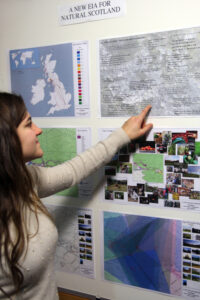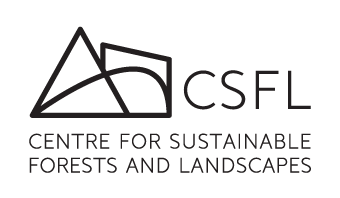What do artists know?
Why is it useful for environmental researchers and creative practitioners to collaborate? One answer might be that many of the most intransigent issues for researchers fall into areas where artists traditionally thrive. It can be difficult to engage stakeholders with research or provoke action in response; for many, the vital issues being researched can feel nebulous or distant; environmental questions may involve complexities or ambiguities. Communication, engagement and uncertainty are all areas where artists are used to working, making them helpful collaborators for deepening the impact of research.
Furthermore, artists can offer alternative ways of thinking that make them useful collaborators during the research process itself. It is increasingly agreed that addressing climate change is a cultural as well as a technical question, requiring changes to how we think, imagine, and see ourselves. In her seminal manifesto, ‘What do Artists Know’, Frances Whitehead argued that artists have much to offer in terms of thought itself as well as producing artistic ‘works’.
For their part, artists can benefit enormously from working in collaboration with researchers, gaining knowledge, resources and inspiration, as well as a chance to put their skills into action. As a result, an increasing number of projects with sustainability goals are choosing to collaborate with artists, embedding them deeply into planning and decision making, creating the potential for new successes that neither party could accomplish on their own. This kind of ‘deep collaboration’ differs markedly from alternative models of working with artists, which tend to involve them being approached to help communicate already existing research.
The pain and pleasure of deep collaboration
The benefits of arts-academic collaborations are increasingly clear, but the prospect of undertaking this kind of work can be daunting. The process of collaboration can be difficult, especially between people coming from wildly different fields, and it takes time to develop shared understanding and goals with outcomes often not predictable from the outset. As a result, most collaborations of this kind take time to start to yield results and can be intellectually or emotionally challenging.
But these are of course also the reasons why we want to work together in the first place. If we already thought in the same way, the collaboration would have less to offer, while intellectual and emotional challenges are healthy opportunities to develop our own thinking and confront our preconceptions. Truly interdisciplinary collaboration should be challenging rather than straightforward.
A main barrier that prevents new and exciting collaborations arising is a lack of access to information and resources to build understanding of how they can work, what barriers might be encountered, and information on how to get things going. This can prevent people getting beyond the initial difficulties necessary to collaboration and unlocking the extensive benefits. The Library of Creative Sustainability is a new resource that seeks to address this gap.
What is the Library of Creative Sustainability?
The Library of Creative Sustainability is a freely accessible online resource produced by Creative Carbon Scotland that brings together case studies of some of the most successful projects of this kind, giving detailed descriptions as well as tips and advice for anyone considering embarking on similar work.
The aim is to provide inspiration for the type of work that can be achieved through collaborations that involve the arts and to provide advice and information that will help people to take on new projects and run them effectively. The Library is growing all the time and contributions and feedback are always welcome. Below are two project examples, giving overviews of projects that are included in the Library.
A New Environmental Impact Assessment: Environment, Imagination and Aesthetics
This project was a collaboration between artists Jo Hodges and Robbie Coleman and researcher Dr Claire Haggett. Scotland’s transition to being a net-zero emissions country requires investment in major new renewable energy projects such as windfarms. However, windfarms are not always free of environmental damage and can cause problems for local communities. The collaborators proposed how the process of Environmental Impact Assessments, which new developments such as wind farms must go through to receive planning permission, could be radically altered to include a far greater understanding of the relationship local communities have with the landscape.
They held a series of informal meet ups with residents of a small hamlet adjacent to the site of a proposed new windfarm, involving them in a series of creative activities aimed at understanding their relationship with the place and the effect of the proposed development on this. These activities included taking photographs of favourite views, naming or renaming places on a map there were meaningful to them, recording their feelings during a walk, and creating film posters that ‘narrativized’ their experience of moving to the area.

Image credit: Tim Collins and Reiko Goto
They found that the value of the place was intimately interconnected with residents’ experience of living there and was very difficult to understand from the perspective of an external developer, whose offers of financial reparation did not match the concerns of residents. The collaborators presented the results of these activities in the form of the ‘missing chapter’ of an Environmental Impact Assessment and advocated for these kinds of exercises in empathy being included in the planning process.
The Black Wood of Rannoch
The Black Wood of Rannoch is one of the largest and best-preserved ancient woodlands in Scotland and is of high importance for local biodiversity. It is also widely agreed that long-term environmental sustainability requires rebuilding a sense of our relationship with the natural world, which may require spending more time in natural sites like the Black Wood of Rannoch. The site thus faces a debate over whether more people should be encouraged to come to visit this special place or whether they should be discouraged for fear of damaging its unique ecosystem.
Forest Research worked with artists Timothy Collins and Reiko Goto to interrogate this seemingly unsolvable dilemma. The artists saw the conflict as a positive opportunity to develop our understanding of how these issues of preserving biodiversity and rebuilding a cultural relationship with our forests connect to each other.

Image credit: Jo Hodges and Robbie Coleman
They brought together residents, artists, researchers, and foresters to debate the issues in a non-judgemental space and worked closely with members of the community to understand their perspectives. The artists sought to connect the area’s social history with the history of the forest through various means, including a map featuring the Gaelic names for locations in the forest, created in dialogue with local residents to build up an understanding of the historical reasons for these names, which invariably revealed how intertwined the lives of humans and the forest had been. Artworks like these were then exhibited around the country, building understanding of the importance of this forest without necessarily requiring people to visit in person.
by Lewis Coenen-Rowe
culture/SHIFT officer, Creative Carbon Scotland




Leave a Reply